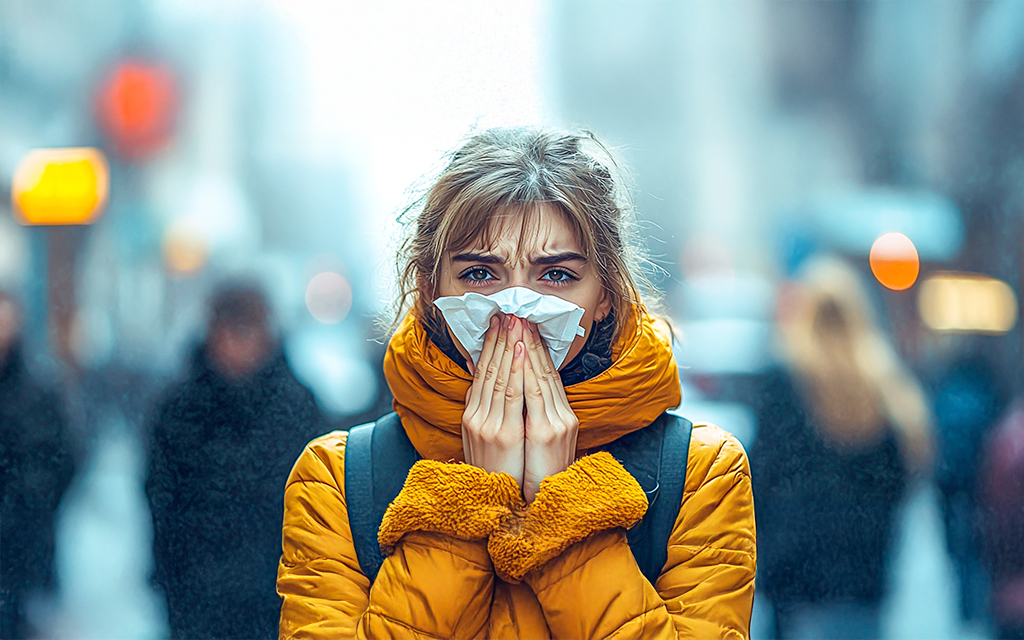This new report from the ClimAIr project marks a significant milestone in advancing our understanding of how environmental factors shape airway allergy outcomes. Focused on developing consensus definitions for single and multipollutant exposures, pollen, and climate conditions, this report provides a standardised framework for categorising patients. By harmonising these definitions, it creates a foundation for both clinical applications and AI-driven research, ultimately contributing to more precise strategies for preventing and managing respiratory diseases such as allergic rhinitis (AR) and asthma.

Background and Rationale
Allergic airway diseases have increased sharply in recent decades, driven by urbanisation, industrialisation, and climate change. These conditions are exacerbated by pollutants, pollen, and microbial agents—together forming what is known as the exposome. Evidence shows that pollutants such as PM2.5, PM10, NO₂, and O₃ are linked to higher prevalence and severity of AR and asthma, particularly in urban areas. Meanwhile, climate change has altered pollen seasons and intensified allergenic potential, further complicating respiratory health.
The ClimAIr deliverable Generation of a Consensus Definition for Single & Multipollutant Exposure and Other Variables that Impact Airway Allergy Outcomes responds to these challenges by creating a structured system to classify patients according to their exposure profiles, thereby enabling researchers and clinicians to link environmental conditions with disease expression and progression.
Consensus Framework and Methodology
The framework organises patient categorisation into three environmental domains:
- Pollution: Patients are classified as exposed to single or multiple pollutant types (e.g., transport, industry, agriculture, natural sources). Classification relies on exposure levels exceeding WHO recommendations for at least six months in the previous year.
- Pollen: Exposure is categorised as single or multiple, with focus on key sensitising species such as Phleum pratense, Olea europaea, and Betula verrucosa, alongside additional regional species.
- Climate: Four categories—warm and humid, warm and dry, cold and humid, cold and dry—are defined by annual temperature averages and cumulative rainfall.
Data for categorisation is sourced from validated institutions such as universities, governmental agencies, hospitals, and municipal monitoring stations. Pollution, pollen, and climate monitoring networks ensure accurate and consistent allocation of patients to exposure categories.
Clinical Implications
This framework has direct relevance to clinical practice. By systematically categorising patients according to their environmental exposures, healthcare providers can:
- Tailor treatment strategies to address specific risks, e.g., intensified interventions for patients exposed to multiple pollutants.
- Anticipate seasonal risks, using climate and pollen data to guide preventive measures.
- Identify vulnerable groups who may benefit from early intervention with therapies such as immunotherapy or antihistamines.
This structured approach supports precision medicine in respiratory care, aligning treatment more closely with environmental and lifestyle factors.
Advancing Research and AI Applications
From a research perspective, the standardised framework enables integration of environmental and clinical data into AI-driven analyses. These analyses can:
- Reveal molecular mechanisms, such as pollutant-induced epigenetic changes in AR patients.
- Model the combined effects of multiple exposures (pollutants + pollen + climate).
- Develop predictive tools to forecast the health impacts of climate change and air pollution, guiding both local interventions and global public health strategies.
The framework also opens new avenues for clinical and experimental research, such as investigating how pollutants chemically alter pollen allergens to enhance inflammatory responses.
Public Health and Policy Relevance
The findings underscore the urgency of integrated public health policies that address the rising burden of allergic airway diseases. These should include:
- Stricter measures to improve air quality and reduce emissions.
- Better indoor environment management to limit exposure to allergens.
- Climate policies that recognise global warming as a driver of longer pollen seasons and expanded allergenic plant ranges.
By linking clinical and environmental data, the report also provides valuable evidence to inform policy decisions aimed at protecting vulnerable populations.
Conclusion
This deliverable represents a pivotal achievement for the ClimAIr project, offering a robust, standardised framework to connect environmental exposures with clinical outcomes in allergic rhinitis and asthma. By bridging environmental science, clinical research, and AI-driven modelling, it lays the groundwork for precision medicine approaches, advanced predictive tools, and evidence-based policymaking.
Through its comprehensive methodology, the report not only advances scientific understanding but also reinforces the importance of collaboration among researchers, clinicians, and policymakers in addressing the growing impact of environmental change on respiratory health.
Read the full report here.